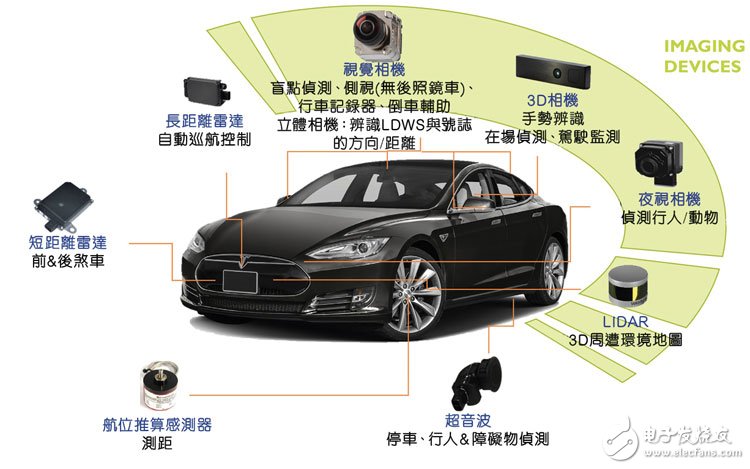Autopilots face a complex challenge when it comes to understanding the road environment. They must not only monitor traffic conditions and interpret road signs but also detect, classify objects, estimate speed and trajectory, and accurately locate themselves on a map to reach their destination safely. This level of perception requires advanced sensor technologies and robust software integration.
Highly automated vehicles depend on a combination of sensors such as cameras, radar, ultrasonic devices, GPS antennas, and LiDAR systems that use optical pulses for distance measurement. Each of these components has its own strengths and limitations, making the integration of data from multiple sources crucial for reliable performance.

Figure 1: A series of sensor technologies installed on a vehicle
Vision cameras are used for blind spot detection, side view monitoring (without traditional mirrors), driving recorders, and rearview stereo cameras. These help identify lane departure warnings, signs, distances, and even support 3D gesture recognition. Night vision cameras enhance visibility in low-light conditions, while LiDAR provides high-resolution 3D mapping. Ultrasonic sensors assist with parking and obstacle detection, and radar systems support both short- and long-range sensing for adaptive cruise control.
To improve the reliability of autonomous systems, engineers first need to address the inherent limitations of individual sensors. The next critical step involves developing effective strategies to fuse data from different sources, ensuring that no vital information is missed. With each sensor operating at its own update rate, combining their outputs becomes increasingly complex—especially when some provide raw data while others offer processed object classifications.
In 2017, there were significant advancements in sensor technology. Phil Magney, founder and head of VSI Labs, noted that "Perception is a major area of the autonomous vehicle (AV) software stack, and there are many innovations happening here." As a result, many tech companies, Tier 1 suppliers, and OEMs began aggressively pursuing sensor technologies they lacked or couldn't develop internally.
During this period, several sensor startups emerged, focusing on the growing autonomous vehicle market. Among the most notable deals was Intel’s $15.3 billion acquisition of Mobileye, which marked a major shift in the industry.
Mobileye had already established itself as a key player in Advanced Driver Assistance Systems (ADAS) and autonomous vehicle technology. By acquiring Mobileye, Intel gained access to critical capabilities in computer vision, sensing, mapping, and driving strategies. Intel aimed to integrate these with its open computing platform to create a more powerful and scalable solution for autonomous driving.
Magney emphasized the importance of cameras as a "must-have" sensor, highlighting their ability to capture high-resolution images that aid in object classification. Modern cameras also support color imaging, which improves recognition accuracy. However, he pointed out a limitation: "The depth perception of cameras is not as strong as that of light-based sensors like LiDAR."
Wireless Access Point (AP) is a new type of wireless network device, it is a network device based on Wi-Fi technology, can convert a wired network into a wireless network, so that you can easily access the network at home, office or public places. The feature of wireless ceilinged AP is that it uses ceilinged design, can be suspended on the wall top or ceiling, and can transmit the signal to a wider range, so that users can have more space in the same building.
Second, the advantages of wireless ceiling AP
1, the advantage of wireless ceiling AP is that it can better meet the requirements of various environments, can better meet the requirements of indoor space, can better meet the requirements of outdoor space, and can better meet the multi-level coverage area.
2, wireless ceiling AP can better meet the requirements of more network users, because it can better support multiple users, and can meet the connection of a variety of network devices, such as can support the connection of computers, smart phones, tablets and other devices.
3, wireless ceiling AP can better meet a variety of network security needs, because it can provide a variety of network security functions, including encrypted transmission, network isolation, access control, content filtering, authentication and other functions, can better protect network security.
Third, the application of wireless ceiling AP
Wireless ceiling AP can be widely used in homes, offices, companies, schools, hotels, restaurants, public places and other places to meet the network needs of different places.
1, Family: Wireless ceiling AP can better meet the network needs of the family, can make the family network coverage larger, family members can more convenient access to the network at home, more secure access to the network.
2, office: Wireless ceiling AP can meet the network needs of the office, can better meet the network needs of multiple users inside the office, can better meet the network needs of multiple users outside the office, can better support the office security network needs.
3, the company: wireless ceiling AP can better meet the company's network needs, can better meet the company's internal network needs of multiple users, can better support the company's security network needs, can better meet the company's external user network needs.
Fourth, the use of wireless ceiling AP
The installation of wireless ceiling AP is very simple, only need to install it on the wall top or ceiling, and then connect it to the network interface, and finally use its configuration software to complete the installation and setup, the use of wireless ceiling AP is very convenient, as long as the network function is enabled, you can allow multiple users to easily access the network in the same building.
Wifi 5 Ceiling Wireless Ap,Wifi Access Point Poe Ceiling Mount,Ceiling Mount Wifi Access Point Home,Access Point Enclosure Ceiling
Shenzhen MovingComm Technology Co., Ltd. , https://www.movingcommtech.com
